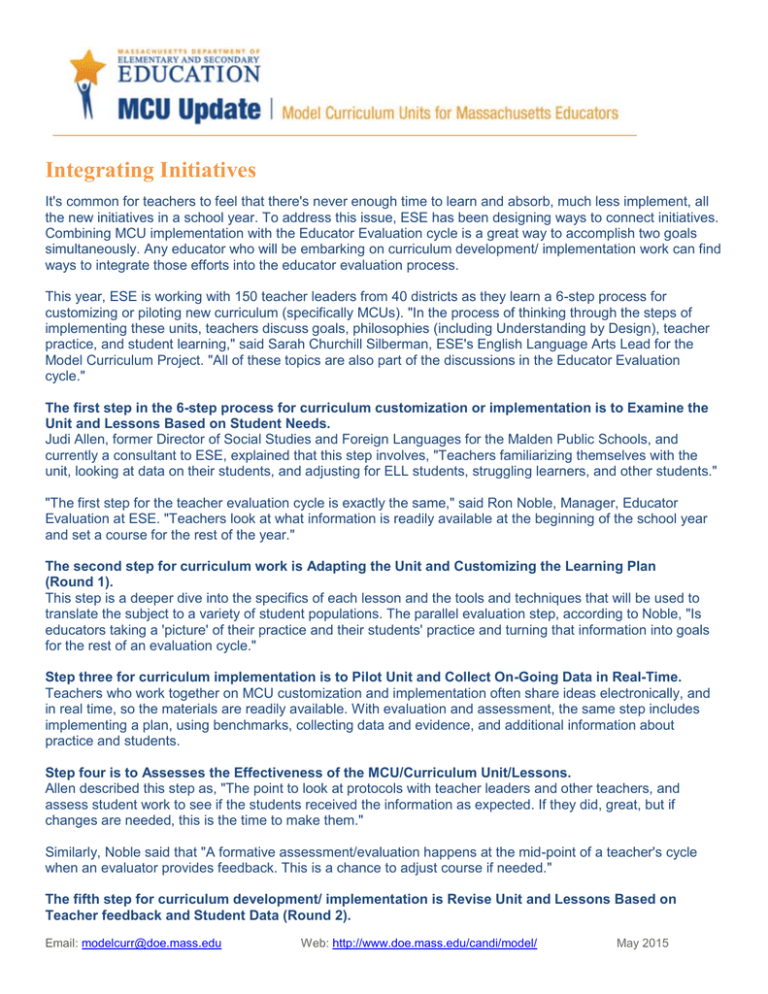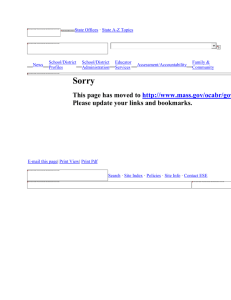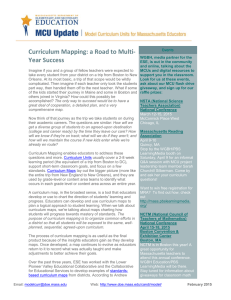2015 May
advertisement

Integrating Initiatives It's common for teachers to feel that there's never enough time to learn and absorb, much less implement, all the new initiatives in a school year. To address this issue, ESE has been designing ways to connect initiatives. Combining MCU implementation with the Educator Evaluation cycle is a great way to accomplish two goals simultaneously. Any educator who will be embarking on curriculum development/ implementation work can find ways to integrate those efforts into the educator evaluation process. This year, ESE is working with 150 teacher leaders from 40 districts as they learn a 6-step process for customizing or piloting new curriculum (specifically MCUs). "In the process of thinking through the steps of implementing these units, teachers discuss goals, philosophies (including Understanding by Design), teacher practice, and student learning," said Sarah Churchill Silberman, ESE's English Language Arts Lead for the Model Curriculum Project. "All of these topics are also part of the discussions in the Educator Evaluation cycle." The first step in the 6-step process for curriculum customization or implementation is to Examine the Unit and Lessons Based on Student Needs. Judi Allen, former Director of Social Studies and Foreign Languages for the Malden Public Schools, and currently a consultant to ESE, explained that this step involves, "Teachers familiarizing themselves with the unit, looking at data on their students, and adjusting for ELL students, struggling learners, and other students." "The first step for the teacher evaluation cycle is exactly the same," said Ron Noble, Manager, Educator Evaluation at ESE. "Teachers look at what information is readily available at the beginning of the school year and set a course for the rest of the year." The second step for curriculum work is Adapting the Unit and Customizing the Learning Plan (Round 1). This step is a deeper dive into the specifics of each lesson and the tools and techniques that will be used to translate the subject to a variety of student populations. The parallel evaluation step, according to Noble, "Is educators taking a 'picture' of their practice and their students' practice and turning that information into goals for the rest of an evaluation cycle." Step three for curriculum implementation is to Pilot Unit and Collect On-Going Data in Real-Time. Teachers who work together on MCU customization and implementation often share ideas electronically, and in real time, so the materials are readily available. With evaluation and assessment, the same step includes implementing a plan, using benchmarks, collecting data and evidence, and additional information about practice and students. Step four is to Assesses the Effectiveness of the MCU/Curriculum Unit/Lessons. Allen described this step as, "The point to look at protocols with teacher leaders and other teachers, and assess student work to see if the students received the information as expected. If they did, great, but if changes are needed, this is the time to make them." Similarly, Noble said that "A formative assessment/evaluation happens at the mid-point of a teacher's cycle when an evaluator provides feedback. This is a chance to adjust course if needed." The fifth step for curriculum development/ implementation is Revise Unit and Lessons Based on Teacher feedback and Student Data (Round 2). Email: modelcurr@doe.mass.edu Web: http://www.doe.mass.edu/candi/model/ May 2015 This is the point at which teachers reflect on the UbD process, successes achieved, and challenges encountered. "We want teaches to give students an opportunity to really try these units and lessons, but we also acknowledge that some student populations differ," said Allen. "We want to keep the integrity of units while being able to customize them for particular populations. And by creating these units collaboratively, and working hard at customizing them, we're looking at sustainability." Noble also sees great value in the overlap of curriculum development/implementation and teacher self evaluation. "Both of these processes provide opportunities for continuous improvement. And because these processes are also about collaboration, every chance to formalize an arrangement to work with multiple teachers should be jumped on." Building Aligned Curriculum Training The Building Aligned Curriculum Training, June 17-18, Westford Regency Conference Center is an opportunity for districts to strengthen alignment of existing curricula to the MA Curriculum frameworks. The training will prepare teacher leaders to work with teams of teachers on effectively adapting and implementing model curriculum units. This training will prepare teachers to guide teams through the steps of planning, adapting, and implementing frameworks-aligned curriculum. In addition, techniques for using data to modify curriculum, connect to educator evaluation, and facilitate and review new pilot curricula will be provided. Teacher leaders will leave the training prepared to successfully customize, pilot, and revise a new curriculum unit, and curriculum committees working over the summer to prepare new resources for their districts will find this opportunity particularly useful. Registration is limited to two teacher leaders per district (through May 29th, with registration reopening on June 3rd if space is available). Register here or see more information on the ESE web site. Note: This training is not open to teacher leaders who have previously attended the Building Aligned Curriculum Grant (Fund Code 133) training. Questions: Please contact Sarah Churchill Silberman, schurchill@doe.mass.edu, 781-338-3586 or Karen White, kwhite@doe.mass.edu, 781-338-3588 Email: modelcurr@doe.mass.edu Web: http://www.doe.mass.edu/candi/model/ May 2015




